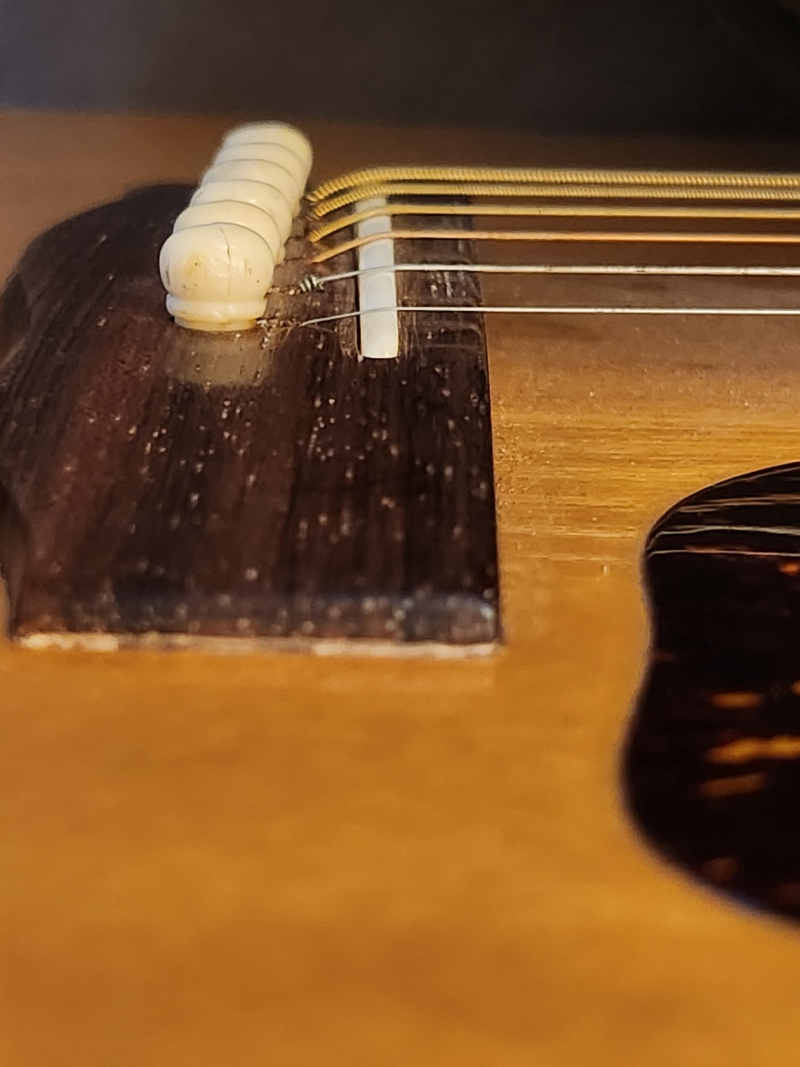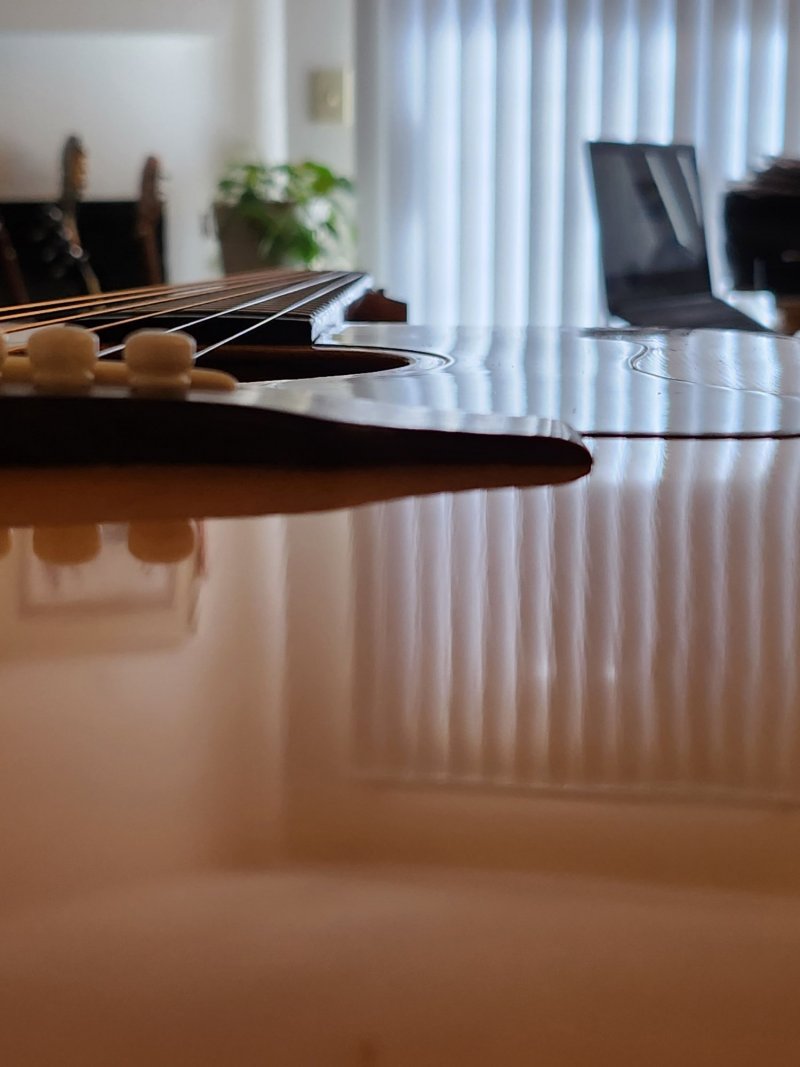Wilmywood,
First, thank-you for explaining why you prefer to play extra light strings... it helps us (me) understand why you immediately dismissed several suggestions that going to heavier gauge strings could be used to remedy a back bow of the neck (when we thought that was the issue).
The next thing I would like to point out is that comparing saddle height between two 50 year old guitars is not a valid judge of how the guitars should be setup... even if the guitars were the same year, same model. Even, really, if they were sister guitars made in the same batch on the same day. There are probably many reasons for this, but several that come to mind are, first, the guitars were made largely by hand in the 1970s, and there would be slight variations from one to the next. For example, when attaching the necks, a very slight difference in the neck angle would affect the optimum height of the bridge and saddle. It's my understanding from LTG members that worked in the Westerly factory that Guild actually had bins of bridges and saddles with different heights, and after the neck was set, would pick the bridge that "fit" the neck angle, and then pick the appropriate saddle. Another reason is that these guitars are made of wood and glue. Each is an individual, unique instrument, and they will age differently. No two pieces of wood will age identically... the necks will bend to varying degrees, the neck joints will "give" to string tension to varying degrees over the years, and the tops will "belly" under string tension to various degrees based on the characteristics of the unique pieces of wood from which they were made.
I own examples of just this situation... I have have two 1994 Guild DV-72s, built just a few months apart: a DV-72NT with a top date in Feb 1994, and a DV-72MK with a top date from Apr 1994. The only difference in these guitars is the color of the reconstituted stone inlay... the NT is turquoise, the MK is green malachite. The 72NT has a saddle that measures (with digital caliper) 0.183" under the E string. The saddle of the 72MK measures 0.110" under the E string. Yet, the 72NT, with the taller saddle, has LOWER action (0.095" at the 12th fret E) than the 72MK with the lower saddle (0.10" 12th fret E).
That said... here is how I would approach setting up your guitar to meet YOUR needs, with a disclaimer that I am NOT a trained luthier or guitar tech, but have been doing my own setups (incl making nuts, saddles, adjusting truss rods, and minor fret work)on my Guilds for more than 10 years.
First, I would adjust the truss rod to give the appropriate relief USING YOUR PREFERRED STRINGS. IIRC, the "factory spec" for neck relief during the Westerly years was 0.006-0.012". Relief is measured by capoing the 1st fret, fretting at the 14ths (where the neck joins the body) and measuring the gap between the top of the 7th fret (or 8th, depending on how you talk to) and the bottom of the E string. Fingerstyle players tend to prefer flatter necks, as the bottom end of the range, hard-driving bluegrass players often prefer more relief... near the top end of the range. For you, I'd probably try the low end first (0.006" or so), tho' the extra light gauge strings MIGHT need it to be a bit more.
The next thing I would do is adjust the nut slots... IMO, this is a critical aspect of how "easy" a guitar is to play... particularly the nut action of the treble strings. A common way to judge "action" at the nut is to put a capo between the 2nd and 3rd frets, and then look for a TINY gap between the strings and the top of the first fret. Smaller gaps under the treble strings, larger (but still tiny) gaps under the bass strings. Some judge the gap by eye, some judge by tapping the strings right above the first fret. If the string "clicks" against the fret, there is a gap, if it doesn't click, the string is resting on the fret. They listen for the click. The techs I used for setups before I started doing my own, and everything I see on the web will always leave a tiny gap between each of the strings and the 1st fret.
In my experience, (if the frets are decently level and in good shape) action at the nut can be lower than most techs will set, particularly on the treble strings... and this slight difference of only a few 1000ths of an inch, makes a world of difference in how easy a guitar is to play (particularly when barring chords near the nut, which I do a lot).
I judge the action at the nut by sound... with a capo between 2nd and 3rd frets (string is resting on the second), I pluck the string with a pick. Then, I fret the string at the first fret and pluck it again. IF THE PITCH CHANGED when I fret at the first, there is a gap, if not, the string is resting on the fret. If it buzzes, the string is VERY CLOSE. I use the pitch change (or lack thereof) and/or buzzing to decide when my action is "optimum" for me. Starting with all the strings clearing the first (that TINY gap I mentioned), I will use nut slot files to lower the treble e and b strings until they are JUST BARELY TOUCHING the first fret when capoed between 2 and 3 (no change in pitch when fretted at 1). The g string is lowered until, when fretted at 1, I hear a SLIGHT BUZZ when plucked, meaning its very close to the first fret, but not touching. The three bass strings are left with tiny gaps that I gauge by eye... with the gaps getting slightly bigger in the progression from 4th (D) to 6th (E).
Adjusting the saddle would be the third step... AFTER setting the relief and action at the nut. For you, I might first try setting the action at the 12th fret at 6/64" (E) and 4/64" (e)... and have you play. See how it feels, see how it plays. Can you fret the chords you want? does it buzz more than you like? If there isn't unacceptable buzzing, I might try dropping the action further... maybe to 5/64" on the E.
Anyway, sorry for the excessively long post... But, that is how I would approach the problem. I guess your tech/luthier will likely approach it much the same way (tho' I would bet he leaves the nut slots higher than I would). Good luck in your efforts... and enjoy making music with your Guilds!




